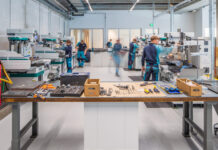By Aimee Clarke
IT’s been more than 200 years since the steam engine changed the trajectory of humanity and industry. It’s been just as long since people started worrying that technology would render them redundant. The steam engine was used to minimise the need for human labour in manufacturing while ramping up production. Sounds familiar?
In 2021, we are facing the same fears (and opportunities) as in the 1800s.
In an exclusive interview with CBN, Marc Van Pelt – MD of Pepperl+Fuchs Africa and chair of the South African-German Chamber of Commerce and Industry’s Working Group 4IR – said: “The manufacturing industry is presented with ever-improving technology with which to boost production, minimise downtime and drive profitability. At the same time, there are delicate socio-economic concerns which must be navigated.” This is especially true for South Africa, where industrial innovation poses a threat to our ability to meet some objectives identified in the National Development Plan (NDP) 2030 and UN Sustainable Development Goals (SDGs), such as:
- SDG 8: The promotion of sustained, inclusive, and sustainable economic growth, full and productive employment, and decent work for all.
- SDG 9: Inclusive and sustainable industrialisation.
- SDG 10: Reduction of inequality within and among countries.
However, while South Africa is looking for ways to meet our development goals, the manufacturing sector is shrinking. The sector’s share of the country’s gross domestic product decreased from 19.3% in 1994 to 12% in 2018. However, according to van Pelt, there are still opportunities abound.
“I believe South Africa is a prime destination for manufacturing. Our automotive manufacturing plants are a perfect example of this. We are globally competitive and can remain so if we keep with pace of change of technology. However, we must be very careful that we do not automate that which does not need to be automated. We must translate innovation into the African context, do business the African way, and take note of how we implement new technology into our manufacturing plants.”
A recent study on the South African manufacturing industry identified the challenges in local adoption of 4IR (fourth industrial revolution) technologies. The data points to social inequalities, resistance to technology, and lacking skills/education as primary concerns. In identifying strategies to improve innovation in South Africa, the study argued for adoption which takes into account the specific national context, aligned to the objectives of the NDP and the SDGs.
What does this look like in practice?
It looks like a people-focused approach. It means taking the time to ensure our graduates are prepared to embrace innovation, with the right educational foundation and adequate 4IR skills. This requires private sector involvement, as SA faces ongoing struggles with a constrained public education system. “We have engaged with universities on this, and encourage other companies in our sector to do the same. By focusing efforts on our young graduates, we can better prepare them for work and foster a mindset which is innovation-positive. We must all contribute to creating the workforce we need,” says Van Pelt.
“Automation is not about reducing labour costs. It’s about improving our production quality to an output which is internationally competitive. We have the potential to be a manufacturing hot-spot, and we need people – aligned with technology – in order to achieve this,” he concludes.
Failure to achieve this means a dwindling manufacturing industry which more job losses on the way.















